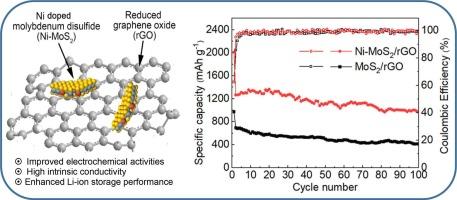还原氧化石墨烯负载的ni掺杂MoS2纳米片具有增强的锂离子存储性能
IF 4.1
3区 化学
Q1 CHEMISTRY, ANALYTICAL
引用次数: 0
摘要
可充电锂电池在消费电子产品、电动汽车和电网存储市场一直扮演着主导角色。目前,石墨作为传统的负极材料,其理论比容量(372 mAh g−1)较低,无法满足高能量密度锂离子电池的要求。本文采用配体辅助水热法合成了Ni-MoS2/rGO复合材料,在还原氧化石墨烯(rGO)上生长的卷曲ni掺杂MoS2纳米片(Ni-MoS2)具有松散的薄层微观结构,具有较高的电化学活性,确保了复合材料优异的锂离子存储性能。得益于Ni-MoS2的高电化学活性和氧化石墨烯的高电导率,Ni-MoS2/氧化石墨烯复合材料具有高可逆电容和快速反应动力学。结果表明,Ni-MoS2/rGO复合材料具有高达995 mAh g - 1的可逆锂离子存储容量(100次循环后)和良好的倍率性能。本文章由计算机程序翻译,如有差异,请以英文原文为准。

Reduced graphene oxide supported Ni-doped MoS2 nanosheets with enhanced lithium-ion storage performance
Rechargeable LIBs have been playing the dominant role in the market of consumer electronics, electric vehicles, and grid storage. At present, graphite, as a traditional anode material, cannot meet the requirements of high-energy-density LIBs due to its low theoretical specific capacity (372 mAh g−1). Here, we report Ni-MoS2/rGO composites synthesized by a ligand-assisted hydrothermal method, in which curled Ni-doped MoS2 nanosheets (Ni-MoS2) grown on reduced graphene oxide (rGO) had a loose thin-layered microstructure with high electrochemical activities, ensuring excellent lithium-ion storage performance of the composites. Benefitting from high electrochemical activities of the Ni-MoS2 and high conductivity of the rGO, the Ni-MoS2/rGO composites exhibited high reversible capacitance and fast reaction kinetics. As a result, a high capacity of reversible lithium-ion storage up to 995 mAh g−1 (after 100 cycles) and a good rate capability were achieved by the Ni-MoS2/rGO composites.
求助全文
通过发布文献求助,成功后即可免费获取论文全文。
去求助
来源期刊
CiteScore
7.80
自引率
6.70%
发文量
912
审稿时长
2.4 months
期刊介绍:
The Journal of Electroanalytical Chemistry is the foremost international journal devoted to the interdisciplinary subject of electrochemistry in all its aspects, theoretical as well as applied.
Electrochemistry is a wide ranging area that is in a state of continuous evolution. Rather than compiling a long list of topics covered by the Journal, the editors would like to draw particular attention to the key issues of novelty, topicality and quality. Papers should present new and interesting electrochemical science in a way that is accessible to the reader. The presentation and discussion should be at a level that is consistent with the international status of the Journal. Reports describing the application of well-established techniques to problems that are essentially technical will not be accepted. Similarly, papers that report observations but fail to provide adequate interpretation will be rejected by the Editors. Papers dealing with technical electrochemistry should be submitted to other specialist journals unless the authors can show that their work provides substantially new insights into electrochemical processes.

 求助内容:
求助内容: 应助结果提醒方式:
应助结果提醒方式:


